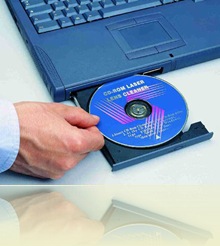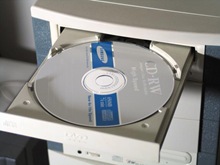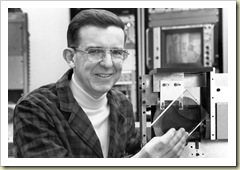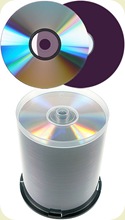يدل مصطلح CD-ROM على الجملة "Compact Disc read-only memory"، وتعني الأقراص المضغوطة القابلة للقراءة فقط، والتي تحقق باكتشافها وتداولها فيما بعد قفزة هائلة لانتشار ملفات الصوت والصورة، ويرجع اكتشافها إلى المهندس الكهربائي والعالم الفيزيائي "جيمس راسيل James Rusell".
ولد (راسيل) في واشنطن عام 1931م، وعندما شب وترعرع أصبح يتضايق كثيرا إلى حد الضجر والإحباط من التلف الذي يصيب تسجيلات الفونوجراف (والفونوجراف هو جهاز صوتي قديم) حيث كان يمتلك الكثير منها، فحاول جاهدا أن يتخلص من تلك المشاكل وتحسين الجودة والنوعية التي كان أيضا غير راض عنها في تلك التسجيلات.
فبدأ باستخدام إبرة الصبار وثبتها في جهاز الفونوجراف، ولكنه استمر في التفكير في طريقة أفضل للتسجيل، وبما أنه فيزيائي متخصص وبارع في الأجهزة الكهربائية حيث إنه صمم أول جهاز (لِحام) يستخدم الحزمة الإلكترونية في تشغيله، فما كان منه إلا أن فكر بطريقة مبتكرة وجديدة قلبت موازين صناعة تخزين البيانات؛ حيث استخدم الضوء بدلا عن الطريقة السابقة وذلك بالتعبير عن الخانتين (0) و (1) بـ (عاتم) و (مضيء)، وبهذه الطريقة لن يكون هناك سهولة في التلف أو الضرر.
هكذا كانت الفكرة، وبعد سنوات من العمل المتواصل وبتشجيع من الشركة أو المؤسسة التي يعمل بها، استطاع (راسيل) في عام 1970م أن ينجح في اختراع أول تسجيل (رقمي- ضوئي)، حيث قام بالتسجيل على طبق كبير حساس للضوء في خانات دقيقة تحتوي (الضوء، العتمة) بدل (0.1)؛ حيث إن قطر كل خانة (1ميكرون= 10 مرفوع للأس -6 من المتر)، ويقرأ تلك الخانات شعاع ليزري الذي بدوره بنقلها إلى الحاسب الآلي الذي يترجمها إلى إشارات إلكترونية لتحويلها في النهاية إلى صوتية أو مرئية.
وكعادة الاكتشافات الجديدة حيث تواجه بالخوف والتوجس لم يجد (راسيل) أحداً يتبنى هذه الفكرة حتى قبلت شركة سوني اليابانية شراء حقوق الملكية الفكرية لتبدأ مرحلة الإنتاج التطوير، حتى وصلت (هذه التقنية إلى ما يسمى Digital Versatile Disc (DVD)؛ وهو ما يستطيع تسجيل وتخزين البيانات بشكل مكثف أكثر بكثير من قرص الليزر العادي.
أما بالنسبة لنظام تخزين البيانات فيه فيسمى ISO9660 ، وسرعات سواقة الأقراص الليزرCD-ROM driver فكل سرعة X1 تعتبر قيمتها KBps 150؛ أي 150كيلو بت في الثانية، وبالتالي فإن x32 = 4800 Kbps وكذلك x60 = 9000 Kbps ، وهكذا.
James T. Russell
The Digital Compact Disc
The digital compact disc, now commonplace in stereos and computers, was invented in the late 1960s by James T. Russell.
Russell was born in Bremerton, Washington in 1931. At age six, he invented a remote-control battleship, with a storage chamber for his lunch. Russell went on to earn a BA in Physics from Reed College in Portland in 1953. Afterward, he went to work as a Physicist in General Electric's nearby labs in Richland, Washington.
At GE, Russell initiated many experimental instrumentation projects. He was among the first to use a color TV screen and keyboard as the sole interface between computer and operator; and he designed and built the first electron beam welder. In 1965, when Columbus, Ohio - based Battelle Memorial Institute opened its Pacific Northwest Laboratory in Richland, Washington, Russell joined the effort as Senior Scientist. He already knew what avenue of research he wanted to pursue.
Russell was an avid music listener. Like many audiophiles of the time, he was continually frustrated by the wear and tear suffered by his vinyl phonograph records. He was also unsatisfied with their sound quality: his experimental improvements included using a cactus needle as a stylus. Alone at home on a Saturday afternoon, Russell began to sketch out a better music recording system --- and was inspired with a truly revolutionary idea.
Russell envisioned a system that would record and replay sounds without physical contact between its parts; and he saw that the best way to achieve such a system was to use light. Russell was familiar with digital data recording, in punch card or magnetic tape form. He saw that if he could represent the the binary 0 and 1 with dark and light, a device could read sounds or indeed any information at all without ever wearing out. If he could make the binary code compact enough, Russell saw that he could store not only symphonies, but entire encyclopedias on a small piece of film.
Battelle let Russell pursue the project, and after years of work, Russell succeeded in inventing the first digital-to-optical recording and playback system (patented in 1970). He had found a way to record onto a photosensitive platter in tiny "bits" of light and dark, each one micron in diameter; a laser read the binary patterns, and a computer converted the data into an electronic signal --- which it was then comparatively simple to convert into an audible or visible transmission.
This was the first compact disc. Although Russell had once envisioned 3x5-inch stereo records that would fit in a shirt pocket and a video record that would be about the size of a punch card, the final product imitated the phonographic disc which had been its inspiration. Through the 1970s, Russell continued to refine the CD-ROM, adapting it to any form of data. Like many ideas far ahead of their time, the CD-ROM found few interested investors at first; but eventually, Sony and other audio companies realized the implications and purchased licenses.
By 1985, Russell had earned 26 patents for CD-ROM technology. He then founded his own consulting firm, where he has continued to create and patent improvements in optical storage systems, along with bar code scanners, liquid crystal shutters, and other industrial optical instruments. His most revolutionary recent invention is a high-speed optical data recorder / player that has no moving parts. Russell earned another 11 patents for this "Optical Random Access Memory" device, which is currently being refined for the market.
James T. Russell has many interests beyond optical data devices. In fact, he has claimed, "I've got hundreds of ideas stacked up --- many of them worth more than the compact disc. But I haven't been able to work on them." Digital engineers and consumers alike will be lucky if he does find the time.
مواضيع مشابهة :





ليست هناك تعليقات:
إرسال تعليق